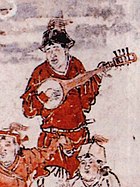Sarod
The Sarod is a stringed instrument, used mainly in Hindustani music on the Indian subcontinent. Along with the sitar, it is among the most popular and prominent instruments.[1] It is known for a deep, weighty, introspective sound, in contrast with the sweet, overtone-rich texture of the sitar, with sympathetic strings that give it a resonant, reverberant quality. A fretless instrument, it can produce the continuous slides between notes known as meend (glissandi), which are important in Indian music.[2][3]
Origins
Historical instruments
Kushan Empire, 1st to 3rd century. Lute or vina, from the Yusufzai district near Peshawar. Greco Buddhist (Gandhara School). Resembles rubab, sarod and tungna.
- ↑ "sarod · Grinnell College Musical Instrument Collection". omeka1.grinnell.edu. Retrieved 2019-10-13.
- ↑ "Classical Indian Musician Amjad Ali Khan to Perform March 1 at FAC". Office of News & Media Relations | UMass Amherst. Retrieved 2019-10-13.
- ↑ "ITC Sangeet Research Academy". www.itcsra.org. Retrieved 2019-10-13.



